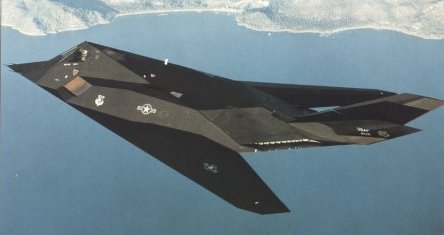F-117A Nighthawk

Mission
The F-117A Nighthawk is the world's first operational aircraft designed to exploit low-observable stealth technology. This precision-strike aircraft penetrates high-threat airspace and uses laser-guided weapons against critical targets.
Features
The unique design of the single-seat F-117A provides exceptional combat capabilities. About the size of an F-15 Eagle, the twin-engine aircraft is powered by two General Electric F404 turbofan engines and has quadruple redundant fly-by-wire flight controls. Air refuelable, it supports worldwide commitments and adds to the deterrent strength of U.S. military forces.
The F-117A can employ a variety of weapons and is equipped with sophisticated navigation and attack systems integrated into a digital avionics suite that increases mission effectiveness and reduces pilot workload. Detailed planning for missions into highly defended target areas is accomplished by an automated mission planning system developed, specifically, to take advantage of the unique capabilities of the F-117A.
Background
The F-117A production decision was made in 1978 with a contract awarded to Lockheed Advanced Development Projects, the "Skunk Works," in Burbank, Calif. The first flight over the Nevada test ranges was on June 18, 1981, only 31 months after the full-scale development decision.
Streamlined management by Aeronautical Systems Center, Wright-Patterson Air Force Base, Ohio, combined breakthrough stealth technology with concurrent development and production to rapidly field the aircraft.
The first F-117A was delivered in 1982, and the last delivery was in the summer of 1990. Air Combat Command's only F-117A unit, the 4450th Tactical Group, (now the 49th Fighter Wing, Holloman Air Force Base, N.M.), achieved operational capability in October 1983.
During Operation Desert Storm in 1991, F-117A's flew approximately 1,300 sorties and scored direct hits on 1,600 high-value targets in Iraq. It was the only U.S. or coalition aircraft to strike targets in downtown Baghdad. Since moving to Holloman AFB in 1992, the F-117A and the men and women of the 49th Fighter Wing have deployed to Southwest Asia more than once. On their first trip, the F-117s flew non-stop from Holloman to Kuwait, a flight of approximately 18.5 hours -- a record for single-seat fighters that stands today.
In 1999, 24 F-117A's deployed to Aviano Air Base, Italy, and Spangdahlem AB, Germany, to support NATO's Operation Allied Force. The aircraft led the first Allied air strike against Yugoslavia on March 24, 1999.
Returning to the skies over Baghdad, F-117A's launched Operation Iraqi Freedom with a decapitation strike on March 20, 2003. Striking key targets in the toppling of Saddam Hussein’s regime, 12 deployed F-117s flew more than 100 combat sorties in support of the global war on terrorism.
The F-117A program demonstrates that stealth aircraft can be designed for reliability and maintainability. It created a revolution in military warfare by incorporating low-observable technology into operational aircraft. The aircraft receives support through a Lockheed-Martin contract known as Total System Performance Responsibility.
General Characteristics
Primary
Function: Fighter/attack
Contractor: Lockheed
Aeronautical Systems Co.
Power
Plant: Two General Electric F404 engines
Length: 63 feet, 9 inches (19.4 meters)
Height: 12 feet, 9.5 inches (3.9 meters)
Weight: 52,500
pounds (23,625 kilograms)
Wingspan: 43
feet, 4 inches (13.3 meters)
Speed: High
subsonic
Range: Unlimited
with air refueling
Armament: Internal
weapons carriage
Unit
Cost: $45 million
Crew: One
Date
Deployed: 1982
Inventory: Active force, 55; ANG, 0; Reserve, 0
